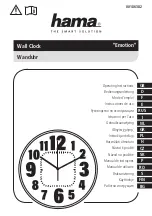
Simple Network Time Protocol (SNTP) is widely used to synchronize time on
computers. The IT Group within an enterprise usually designates a local server
or set of servers responsible for maintaining accurate time as a time standard for
the network. These servers typically synchronize to a reliable external Internet
time source.
The OnTime Clock must be configured with the network location of a time
server. The default time server is an Internet time server operated by Inova
Solutions, but this is intended for temporary use only because IT Groups prefer
not to have individual clocks connecting to the Internet. Your IT Group should
specify a local SNTP or NTP time server or router with which to synchronize the
clocks.
Once a clock is installed, the next step is to confirm or set the configuration.
Though there are a number of settings you can confirm or change on a clock, you
should concentrate on four configuration items initially. These include:
An
IP address
so that the clock can communicate on the network.
A
network time server
so that the clock knows with which computer it
should be synchronized.
The
local time zone
so that the clock can display the correct local time.
The
Daylight Saving Time (DST)
rule so that the clock can automatically
adapt to local DST.
Before working with these settings, however, you have to consider which
configuration method to use. You have three options:
Configuration Method
Description
Reference
The
recommended
method
is to assign both the IP
address and all options via
a DHCP configuration
string.
This method is the only way to address and
configure a group of clocks without requiring a
telnet session into each clock. Clocks are factory set
with DHCP enabled.
Using this method, the DHCP Server is set up with
a clock configuration string. Clocks will
automatically request the configuration string
when they request an IP address.
Section 6
Summary of Contents for OnTime 4-Digit Digital Clocks
Page 1: ......
Page 2: ......
Page 3: ......
Page 4: ......
Page 21: ...Figure 15 Power Up Sequence...
















































